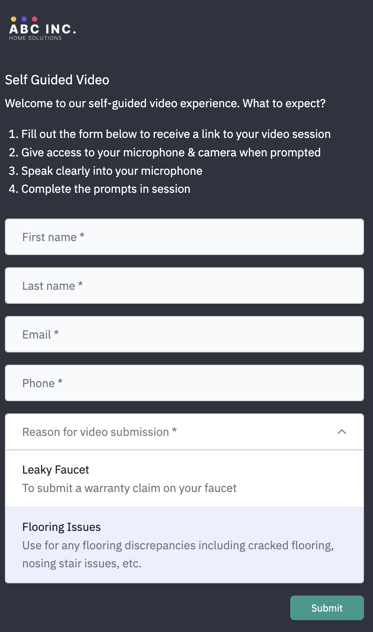IrisCX introduces an innovative solution - Self-Guided customer intake. This section provides a comprehensive overview of this feature, explaining Self-Guided intake and identifying who benefits most from their implementation.
Jump to:
- What is a Self-Guided intake?
- Why is this valuable?
- What does the intake process look like?
- Tutorials
What is a Self-Guided intake?
Self-guided intake in IrisCX is an efficient method to enable customers to self-submit videos for customer facing teams. Customers enter a recorded video environment and follow guides & and prompts to provide essential information in a structured manner. Videos are automatically uploaded to your workspace for the team's review and action, streamlining the intake process while ensuring consistency and completeness.
Why is this valuable?
Self-guided flows are designed to cater to a wide range of scenarios and use cases. Whether you are in customer support, sales, or any field where customer interaction is crucial, Self-Guided Flows can offer substantial benefits. Here are some scenarios where this feature shines:
-
Customer Support Teams: When customers need assistance, they can follow a Self-Guided Flow to provide detailed information about their issue. This approach helps support teams understand customer problems quickly through the context of video and deliver precise solutions.
-
Sales and Onboarding: For sales representatives or onboarding teams, Self-Guided Flows enable customers to submit relevant information about their needs and preferences. This data can be invaluable for tailoring product recommendations and providing a personalized onboarding experience.
- Inspection & Warranty: Customers can easily document product issues, complete assessments, and submit warranty claims through structured video-based guidance. This streamlined approach accelerates processes, improves customer experience, and ensures efficient resolution in inspection and warranty-related tasks.
-
Data Collection: Any situation where structured data collection is vital can benefit from Self-Guided Flows. This could include surveys, feedback collection, compliance forms, and more.
-
Lead Qualification: Sales teams can use Self-Guided Flows to qualify leads by asking specific questions about their needs, budget, and timeline. This information helps prioritize and tailor the sales approach.
-
Consultations and Appointments: Professionals offering consultations or services can gather relevant client information before the meeting, ensuring the session is productive and focused.
Self-guided flows can be tailored to suit your organization's unique needs, making them a versatile and valuable addition to your customer interaction toolkit. Whether you're looking to streamline support, enhance sales processes, or collect structured data, Self-Guided Flows empower your team and customers to achieve more efficient and effective interactions.
What does the intake process look like?
Step 1: Customers access an initial intake form
Customers fill out a simple form to receive access to their Self-Guided Intake Session link and choose a reason for submission.
Note: The intake form is customizable. Visit Getting Started: Self-Guided Intake for a complete setup guide.

Step 2: Customer receives an SMS to initiate their session
Once the form has been initiated, the customer will receive an SMS containing their session link.

Step 3: Customer complete Self-Guided Intake
Customers use the guide and prompts that you have created for them to complete their video intake.

Step 4: Sessions are reviewed in workspace
Once the customer has completed sessions, they are automatically uploaded to your workspace for you to review in your sessions tab to action how you see fit.
Self-guided flows can be tailored to suit your organization's unique needs, making them a versatile and valuable addition to your customer interaction toolkit. Whether you're looking to streamline support, enhance sales processes, or collect structured data, Self-Guided Flows empower your team and customers to achieve more efficient and effective interactions.
Tutorials
